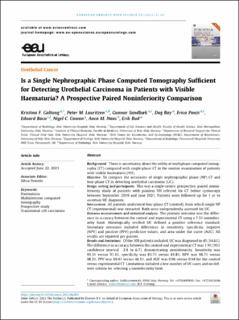| dc.description.abstract | Background: There is uncertainty about the utility of multiphase computed tomog- raphy (CT) compared with single-phase CT in the routine examination of patients with visible haematuria (VH).
Objective: To compare the accuracies of single nephrographic phase (NP) CT and four-phase CT in detecting urothelial carcinoma (UC).
Design, setting, and participants: This was a single-centre, prospective, paired, nonin- feriority study of patients with painless VH referred for CT before cystoscopy between September 2019 and June 2021. Patients were followed up for 1 yr to ascertain UC diagnosis.
Intervention: All patients underwent four-phase CT (control), from which single NP CT (experimental) was extracted. Both were independently assessed for UC. Outcome measurements and statistical analysis: The primary outcome was the differ- ence in accuracy between the control and experimental CT using a 7.5% noninferi- ority limit. Histologically verified UC defined a positive reference standard. Secondary outcomes included differences in sensitivity, specificity, negative (NPV) and positive (PPV) predictive values, and area under the curve (AUC). All results are reported per patient.
Resultsandlimitations: Ofthe308patientsincluded,UCwasdiagnosedin45(14.6%). The difference in accuracy between the control and experimental CT was 1.9% (95% confidence interval 2.8 to 6.7), demonstrating noninferiority. Sensitivity was 93.3% versus 91.1%, specificity was 83.7% versus 81.8%, NPV was 98.7% versus 98.2%, PPV was 49.4% versus 46.1%, and AUC was 0.96 versus 0.94 for the control versus experimental CT. Limitations included a low number of UC cases and no def- inite criteria for selecting a noninferiority limit.
Conclusions: The accuracy of NP CT is not inferior to that of four-phase CT for detect- ing UC.
Patient summary: This study shows that a computed tomography (CT) examination with only one contrast phase is no worse than a more complex CT examination for detecting cancer in the urinary tract among patients presenting with visible blood in the urine. | en_US |

